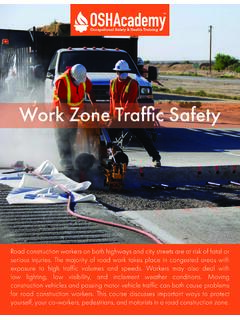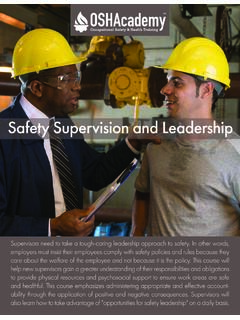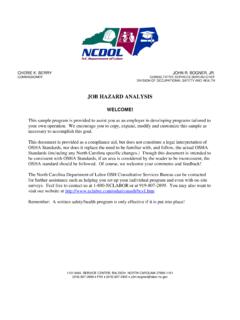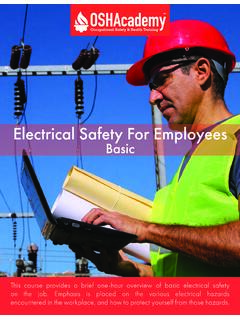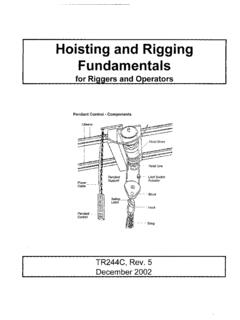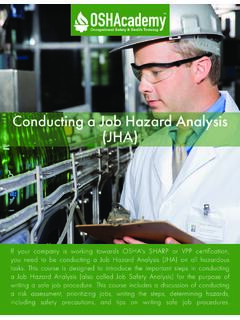Transcription of Focus Four: Electrocution Hazards - OSHA Training
1 Focus Four: Electrocution Hazards This is the fourth course covering the Hazards described in our Construction Focus Four Hazards series. The Focus Four Hazards series was developed to help educate workers in the construction industry about understanding the Hazards they face, and knowing what their employer's responsibilities are to protect workers from workplace Hazards . Once students complete this course they will be able to identify common Electrocution Hazards , describe types of Electrocution Hazards , protect themselves from Electrocution Hazards , and recognize employer requirements to protect workers from Electrocution Hazards . This page intentionally blank osha cademy Course 809 Study Guide Focus Four - Electrocution Copyright 2020 Geigle Safety Group, Inc. No portion of this text may be reprinted for other than personal use.
2 Any commercial use of this document is strictly forbidden. Contact osha cademy to arrange for use as a Training document. This study guide is designed to be reviewed off-line as a tool for preparation to successfully complete osha cademy Course 809. Read each module, answer the quiz questions, and submit the quiz questions online through the course webpage. You can print the post-quiz response screen which will contain the correct answers to the questions. The final exam will consist of questions developed from the course content and module quizzes. We hope you enjoy the course and if you have any questions, feel free to email or call: osha cademy 15220 NW Greenbrier Parkway, Suite 230. Beaverton, Oregon 97006. +1 (888) 668-9079. Disclaimer This document does not constitute legal advice. Consult with your own company counsel for advice on compliance with all applicable state and federal regulations.
3 Neither Geigle Safety Group, Inc., nor any of its employees, subcontractors, consultants, committees, or other assignees make any warranty or representation, either express or implied, with respect to the accuracy, completeness, or usefulness of the information contained herein, or assume any liability or responsibility for any use, or the results of such use, of any information or process disclosed in this publication. GEIGLE SAFETY GROUP, INC., DISCLAIMS ALL OTHER WARRANTIES EXPRESS OR IMPLIED INCLUDING, WITHOUT LIMITATION, ANY. WARRANTIES OF MERCHANTABILITY OR FITNESS FOR A PARTICULAR PURPOSE. Taking actions suggested in this document does not guarantee that an employer, employee, operator or contractor will be in compliance with applicable regulations. Ultimately every company is responsible for determining the applicability of the information in this document to its own operations.
4 Each employer's safety management system will be different. Mapping safety and environmental management policies, procedures, or operations using this document does not guarantee compliance regulatory requirements. Revised: July 14, 2020. This page intentionally blank Contents Course Introduction .. 1. Module 1: What is an Electrocution Hazard? .. 2. Introduction .. 2. The Standards .. 2. Examples .. 2. Contact with Power Lines .. 5. Real-World 5. Contact with Energized Sources .. 7. Real-Life Accident .. 8. Improper Use of Extension and Flexible Cords .. 10. Real-Life Example .. 11. Module 2: Protection from Electrocution Hazards .. 12. Table A - Minimum Clearance Distances .. 12. Real-World Accident .. 14. What Must Your Employer do to Protect You? .. 15. Training .. 15. Real-World Accident.
5 16. Ground Fault Circuit Interrupters .. 17. An Example of How a GFCI Works .. 17. Real-Life Accident .. 17. Types of GFCI .. 18. Assured Equipment Grounding Conductor Program (AEGCP) .. 20. Inspect Portable Tools and Extension Cords .. 20. Course 809. Wire Size and Ampacity .. 21. 22. Using Power Tools and Equipment .. 22. Misusing Equipment .. 23. Lockout/Tagout 24. Real-World Accident .. 25. Employer Lockout/Tagout Responsibilities .. 26. Appendix A .. 28. Appendix B .. 30. Appendix C .. 31. Glossary .. 38. Endnotes .. 51. This page intentionally blank Course 809. Course Introduction Welcome to Focus Four- Electrocution Hazards for the construction industry. This is the fourth course covering the Hazards described in our Construction Focus Four Hazards series. Please be sure to complete the series by also taking courses 806, 807, and 808.
6 The Focus Four Hazards series was developed in support of the Occupational Safety and Health Administration ( osha ). Construction Outreach Program's effort to help educate workers in the construction industry about: understanding the Hazards they face; and knowing what their employer's responsibilities are to protect workers from workplace Hazards . Construction is among the most dangerous industries in the country and construction inspections comprise 60% of osha 's total inspections. In 2013, preliminary data from the Bureau of Labor Statistics indicate there were 796 fatal on-the-job injuries to construction workers more than in any other single industry sector and nearly one out of every five work- related deaths in the that year. Also in 2013, private industry construction workers had a fatal occupational injury rate almost three times that of all workers in the United States: per 100,000 full-time equivalent construction workers versus for all workers.
7 Given current osha and industry information regarding construction worksite illnesses, injuries and/or fatalities, students that complete this course will be able to recognize fall Hazards , caught-in or-between Hazards , struck-by Hazards , and Electrocution Hazards ( Focus four Hazards ) employees face in the construction industry. Students completing the four courses in the Focus Four Hazards series will be able to recognize fall Hazards , caught-in or -between Hazards , struck-by Hazards , and Electrocution Hazards employees face in the construction industry. Specifically, once students complete the Focus Four Hazards series they will be able to: identify common Focus four Hazards describe types of Focus four Hazards protect themselves from Focus four Hazards recognize employer requirements to protect workers from Focus four Hazards Copyright 2017 Geigle Safety Group, Inc.
8 Page 1 of 51. Course 809. Module 1: What is an Electrocution Hazard? Introduction Electricity is essential to modern life, both at home and on the job. Some employees - engineers, electricians, electronic technicians, and power line workers, among them - work with electricity directly. Electrocution results when a person is exposed to a lethal amount of electrical energy. According to the Bureau of Labor Statistics (BLS), there were more electrical fatalities in construction than any other industrial sector. A total of 86 electrical fatalities in construction occurred in 2018. The Standards osha standards cover many electrical Hazards in many different industries. osha 's general industry electrical safety standards are published in: through Design Safety Standards for Electrical Systems, and through Electrical Safety-Related Work Practices Standards.
9 osha also has electrical safety standards for: Construction - in 29 CFR 1926, Subpart K. Marine terminals - in 29 CFR 1917, and longshoring, in 29 CFR 1918 reference the general industry electrical standards in Subpart S of Part 1910. Shipyard standards - 29 CFR 1915, cover limited electrical safety work practices in 29. CFR Examples Two workers were moving an aluminum ladder. The ladder came in contact with the overhead power lines and electrocuted one of the workers. When a worker raised the mast on his water well drilling truck, it came into contact with high voltage overhead lines and electrocuted him. Copyright 2020 Geigle Safety Group, Inc. Page 2 of 51. Course 809. The boom of a rotary drilling truck contacted an overhead power line and electrocuted the worker. The victim and another worker had just finished drilling a water well on a residential property.
10 The victim moved the truck away from the well. The victim was standing at the controls, lowering the boom and was thrown several feet away from the truck. A worker fell to the concrete floor while working from an 8' fiberglass step ladder. He was fatally injured and electrocuted. The worker was changing an energized ballast on a two-bulb fluorescent light fixture, located approximately 11' 6" off the ground. A worker was electrocuted while connecting a replacement electrical service box to the electrical service drop to the building. Quiz Instructions After each section, there is a quiz question. Make sure to read the material in each section to discover the correct answer to these questions. Circle the correct answer. When you are finished go online to take the final exam. This exam is open book, so you can use this study guide.

